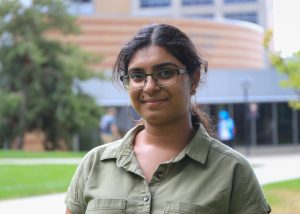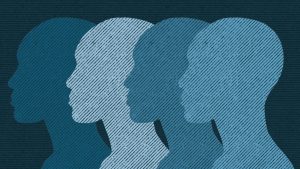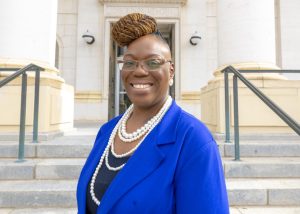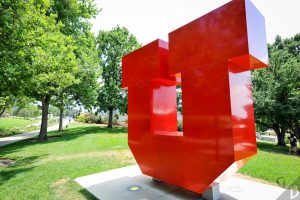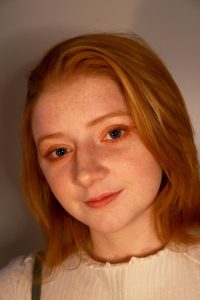How the U’s LGBT Resource Center Has Evolved Over the Last 20 Years
Stuart Moffatt and Rachel Tews show their mask and support at the 2022 LGBT Resource Center 20-year Gay-la held at the Museum of Fine Arts in Salt Lake City on Saturday, Oct. 29 2022. (Photo by Sarah Karr | The Daily Utah Chronicle).
November 8, 2022
The LGBT Resource Center at the University of Utah was founded in 2002 and has been celebrating its 20th anniversary this year, culminating at the center’s annual Gay-la held on Oct. 29.
Though they’ve always sought to empower and support LGBT students, the center has evolved a lot over the years, both in its mission and its physical space.
“I mean, it was literally a closet,” said Gabriella Blanchard, who held several different positions at the center — ranging from student staff to interim director — from 2011 to 2019. “So we all kind of joked about that when we had events or whatever, we’d spill out of the closet; we’d be out in the hall a little bit.”
That was all the space the center had when Blanchard transferred to the U in 2011 — a closet-sized space on the fourth floor of the A. Ray Olpin Union building. “We would cram ourselves in there,” she said. “I mean, we were sitting on each other’s laps, we were sitting on the windowsill, like, we were on the floor.”
Blanchard came from Snow College, a place that she said was not very accepting of queer people at the time.
“I was active in trying to get queer organizing going on that campus,” she said. “Lots of interested, mostly closeted, students. I was older, so I didn’t have as much risk probably; I could just be a big old queer from Utah.”
Despite student interest, the administration and faculty at Snow were not supportive of the group, so it was a nice change of pace when Blanchard transferred to the U and the resource center was an existing campus entity. Although the center had been established for nine years at that point, it was still far from the space that students might know today, even besides the tiny space it occupied.
“Another big change, I think, was just in the thinking at the time,” Blanchard said. “Institutions really viewed centers like that as they existed to serve cisgender straight people, so they were put in place to educate and to do things so that cisgender and heterosexual people understood our community.”
She added that while the center still aimed to support LGBT students, this mindset made it challenging to truly put the focus on their community. “And so I think that was one of the bigger philosophical shifts,” Blanchard said. “To think a little bit more about, like, ‘how do we work for us and make sure that we’re creating spaces that we want to be in?’”
As the center grew and progressed, Blanchard said that they wanted to put the focus back on students as individuals rather than statistics.
“There’s this very numbers-driven and quantitative view of higher-ed and student affairs work, but [it’s important] to think about not necessarily numbers, but who is coming,” she said. “Thinking about who isn’t feeling a sense of belonging on our campus and making sure we’re making events for people that don’t find home in other types of events.”
This change was among the biggest accomplishments Blanchard helped bring about during her time at the center. “Those are probably some of my prouder things while I worked there, was that shift in thinking and challenging straightness a little bit more rather than accommodating straightness,” she said.
Kate Lunnen, Gay-la intern at the resource center and third-year English and gender studies major, is part of the student staff for the center like Blanchard was when she first worked there. Also like Blanchard, Lunnen is a transfer student, from BYU.
“So I started out in a community that wasn’t really as accepting or inviting of, you know, being openly queer, and all of that was very difficult for me, and so when I transferred to the U, I did it because I was making a decision that I wanted to be true to myself,” they said.
The way that Lunnen, as someone who currently works at the resource center, described who they are and what they do is a far cry from the operation running out of a closet that Blanchard started in. They’re still located on the fourth floor of the Union, but the space is much larger. They offer many resources and services to students, such as a computer lab with free printing for students, a lounge area to relax and study in, internships and job opportunities, and full-time staff members available to meet with students to discuss personal or academic struggles. They also hold weekly events to bring queer students together and discuss important issues the LGBT community faces.
“So every week on Friday, we have what’s called Fab Friday or Fabulous Friday, where we meet to play games and just hang out, eat snacks and talk about the week and really meet in the community,” Lunnen said. “Every other Tuesday, our Queer and Trans Students of Color group meets, and they also do different games [and] activities and also have discussions relating to the intersections of race, gender and queerness.”
Lunnen added it’s important to have that kind of space on campus in order to validate and recognize queer students on campus.
“We’re validating all of the queer students at the U who want community, who want to feel like they belong, and we’re also letting them know that we understand that you have unique needs and you have a unique history and unique backgrounds that may or may not be properly served at other places on campus,” they said. “Really, the center kind of acts as a beacon and a central point where people can meet for a community as well.”
Blanchard, as someone who worked at the resource center for many years and was once a queer student at the U, understands better than anyone how important of a role the center has played on campus over the last 20 years.
“For queer people, there’s a need historically to have spaces where we can gather and know that we’ll be safe, just even interact,” she said. “I think that’s the history of it, why it exists now; I mean, I hope it’s to challenge our institution. I hope it’s to continue to create belonging for students for sure. But this university is big and unwieldy, and it needs some sort of organization to challenge our policies, to challenge our practices and make sure that we’re not just paying lip service.”
Lori McDonald, vice president for student affairs, spoke briefly at the 2022 Gay-la about how far the center has come since 2000 when the Lesbian Gay Student Union began to advocate for a designated space on campus.
“It was truly a unified effort from students and staff and faculty and community members who supported this effort that made it happen,” McDonald said. “It is wonderful to be celebrating 20 years; we have a long way to go, I will admit that, but I think it is really wonderful to take time to celebrate where we have come from.”



